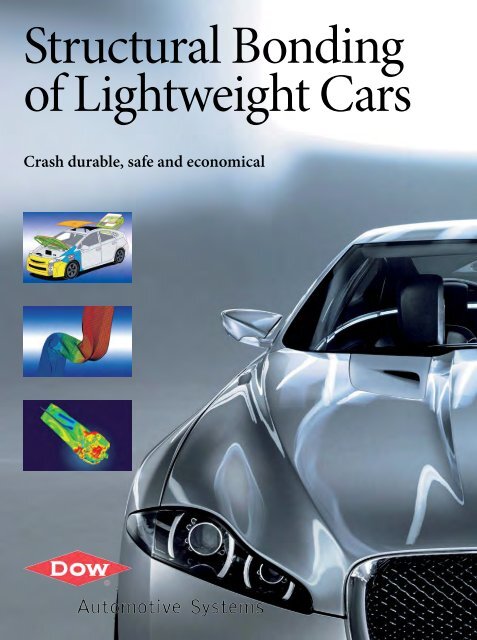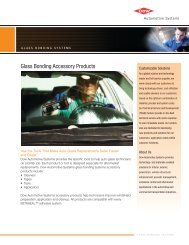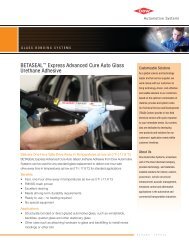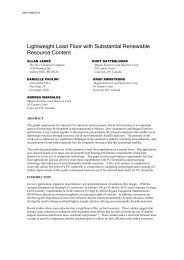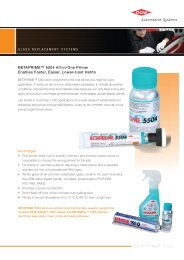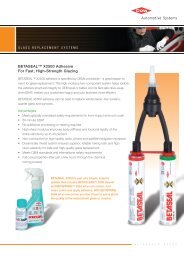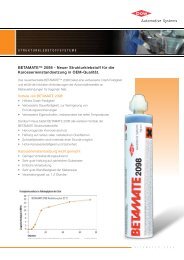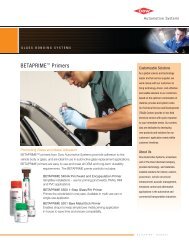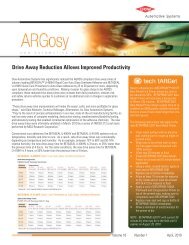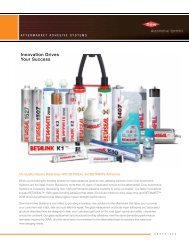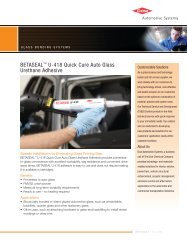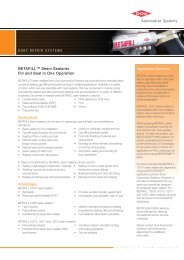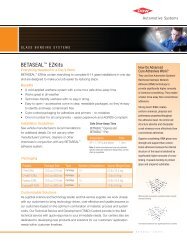Structural Bonding of Lightweight Cars - Dow Automotive Systems
Structural Bonding of Lightweight Cars - Dow Automotive Systems
Structural Bonding of Lightweight Cars - Dow Automotive Systems
You also want an ePaper? Increase the reach of your titles
YUMPU automatically turns print PDFs into web optimized ePapers that Google loves.
<strong>Structural</strong> <strong>Bonding</strong><br />
<strong>of</strong> <strong>Lightweight</strong> <strong>Cars</strong><br />
Crash durable, safe and economical
„Without the use <strong>of</strong> bonding technology, modern lightweight<br />
designs would hardly be feasible – especially when it comes to<br />
bonding dissimilar and/or new materials.“<br />
Dr. Andreas Groß, Advanced Training and Technology Transfer, Fraunh<strong>of</strong>er IFAM<br />
Publisher: <strong>Dow</strong> <strong>Automotive</strong> <strong>Systems</strong> | Am Kronberger Hang 4 | D-65824 Schwalbach | www.dowautomotive.com<br />
Project management: MS&L | Otto-Meßmer-Strasse 1 | D-60314 Frankfurt on the Main<br />
Project coordinator: BestCom Media | Springer Fachmedien Wiesbaden GmbH | Abraham-Lincoln-Straße 46 | D-65189 Wiesbaden<br />
Responsible for the content: Marc van den Biggelaar | <strong>Dow</strong> <strong>Automotive</strong> <strong>Systems</strong><br />
Printing and Processing: Printing company Klimo | Eupen/Belgium | Printed on acid-free and low-chlorine bleached paper | Printed in Belgium.
E d i t o r i a l<br />
<strong>Bonding</strong> Technology<br />
Meets <strong>Lightweight</strong><br />
Construction<br />
Dear Readers,<br />
K l e b - u n d d i c h t s t o f f e<br />
The automotive industry has in recent years successfully attempted<br />
to build lighter vehicles with more fuel-efficient engines<br />
in order to significantly reduce fleet consumption in accordance<br />
with legal requirements. Significantly lower fuel consumption<br />
and CO 2 emissions have been the immediate pay-<strong>of</strong>f <strong>of</strong> such developments.<br />
Improved fuel consumption, environmental friendliness, driving<br />
comfort, and safety therefore feature among the sales arguments<br />
many car manufacturers now employ for their marketing<br />
strategies.<br />
<strong>Automotive</strong> suppliers and material manufacturers support car<br />
makers in developing modern lightweight designs and respond<br />
to questions concerning the potentials <strong>of</strong> current technologies<br />
and materials to satisfy challenging future requirements.<br />
In this context, industry experts assume that steel will remain the<br />
primary material for vehicle structures. However, new high<br />
strength steel grades are finding their way into vehicle structures.<br />
Metals with low density such as aluminium and even magnesium<br />
are increasing in demand – as are polymer materials such as fibre-reinforced<br />
composites.<br />
Fuelled by the importance <strong>of</strong> those very diverse materials, questions<br />
regarding bonding technology enter centre stage <strong>of</strong> the<br />
discussion. This is the key interface between lightweight construction<br />
and bonding technologies for new vehicle designs.<br />
Modern lightweight designs require new bonding technologies<br />
in addition to new materials and/or an increased material mix.<br />
<strong>Bonding</strong> is <strong>of</strong> special importance here. It enables the use <strong>of</strong> new<br />
materials, new material combinations and it provides structural<br />
advantages for bonded components.<br />
Please review the following technical summary to learn more<br />
about the status quo <strong>of</strong> existing concepts as well as new potential<br />
development in adhesives and foams for use in modern light<br />
weight vehicle construction.<br />
I wish you a fascinating read and successful bonding!<br />
Dr. Andreas Lutz<br />
Head Developer “Metal <strong>Bonding</strong> Europe“<br />
<strong>Dow</strong> <strong>Automotive</strong>, Horgen, Switzerland
K l e b - u n d d i c h t s t o f f e<br />
<strong>Structural</strong> adhesives<br />
The key to making lightweight cars<br />
Modern lightweight designs require new bonding technologies in addition to new<br />
materials and/or an increased material mix. <strong>Bonding</strong> is <strong>of</strong> special importance here. It<br />
enables the use <strong>of</strong> new materials, new material combinations and it provides structural<br />
advantages for bonded components.<br />
1 i n n o v a t i v E l i g h t w E i g h t d E s i g n s i n<br />
v E h i c l E d E v E l o p m E n t<br />
1 . 1 W e I g H T R e D u C T I O n F O R M e e T I n g<br />
F u T u R e L e g A L S T A n D A R D S<br />
Two main factors drive vehicle weight reduction. In addition to<br />
the future maximum values for CO 2 emissions as expressed in<br />
the eu Directive 443/2009, an increasing number <strong>of</strong> countries<br />
are planning road usage fees based on such emissions. Both factors<br />
in combination with increased fuel prices result in a strong<br />
motivation to purchase low emission vehicles.<br />
Fuel consumption can be lowered by a number <strong>of</strong> different<br />
methods. <strong>Lightweight</strong> vehicle construction is a significant factor<br />
throughout, immediately contributing to reducing fuel consumption.<br />
Savings by downgauging vehicle components such<br />
as powertrain, engine, and underbody yield further secondary<br />
effects. Various studies show that a 100 kg weight reduction results<br />
in reduced emissions <strong>of</strong> 5.0 to 12.5 g <strong>of</strong> CO 2 (ca. 3 to 7 %)<br />
per driven kilometre.<br />
Representing approximately 40 % <strong>of</strong> total vehicle weight, the car<br />
body is the heaviest vehicle element. The consequent implementation<br />
<strong>of</strong> lightweight measures in the car body appears<br />
therefore very effective. Increasing demands regarding stiffness,<br />
acoustics, crash performance and long-term stability are generally<br />
in conflict with lightweight construction and underline the<br />
complexity <strong>of</strong> this challenge.<br />
www.lightweight-design.de<br />
1 . 2 C u R R e n T T R e n D S F O R R e D u C I n g V e H I C L e<br />
W e I g H T<br />
Several methods for weight reduction are available. The three<br />
most important approaches are:<br />
1. use <strong>of</strong> low-density materials<br />
Aluminium, magnesium and plastics/thermoset composites are<br />
<strong>of</strong>ten used in mounted parts and covers. According to a statement<br />
by the Aluminum Association Inc., aluminium contributed<br />
to an average <strong>of</strong> 7.8 % <strong>of</strong> the total weight for passenger vehicles<br />
in the year 2009.<br />
2. Targeted use <strong>of</strong> high-strength materials<br />
High- and highest-strength steels are solutions for wall thicknessreduced<br />
components. Tailored welded or tailored rolled-blanks<br />
are related technologies that make use <strong>of</strong> this principle.<br />
3. Integrated lightweight construction<br />
This is a combination <strong>of</strong> various materials and functional characteristics<br />
based on the use <strong>of</strong> bonding technologies and production<br />
processes.<br />
The most significant lightweight construction trend over recent<br />
years is the use <strong>of</strong> high-strength steels (HSS). even vehicle bodies<br />
<strong>of</strong> the european compact car class now contain a HSS share <strong>of</strong> 50<br />
to 65 %. Without exception, the safety cells <strong>of</strong> today’s cars consist<br />
mainly <strong>of</strong> HSS. Tailored welded or tailored rolled blank technologies<br />
are consequently used for further optimisation.<br />
Another significant trend is the use <strong>of</strong> thermoplastics and thermoset<br />
composites in bonded ro<strong>of</strong> components, hoods, trunk
covers and some body structure components. As the article will<br />
describe in further detail, bonding technology could also solve<br />
the challenge <strong>of</strong> joining various metallic and non-metallic materials.<br />
1 . 3 T H e P A T H T O W A R D A B A L A n C e D C A R<br />
B O D y<br />
As mentioned above, reducing the body weight, while simultaneously<br />
increasing performance, is a complex task. The following<br />
elements are key demands when developing innovative solutions:<br />
1. Increasing the static and dynamic stiffness to improve the<br />
general vehicle quality and to optimize driving and handling<br />
characteristics.<br />
2. Reducing vibrations and noise (noise, vibration, harshness<br />
and acoustics).<br />
3. Optimising crash behaviour to comply with legal and voluntary<br />
safety guidelines (eg: nCAP safety testing)<br />
4. extending vehicle lifespan and long term value via higher<br />
quality and retained driving characteristics.<br />
Improvements in those four areas are by no means the only challenges<br />
when reducing vehicle weight. A new vehicle generation<br />
<strong>of</strong>ten requires the development <strong>of</strong> greater passenger space. Consequently,<br />
new vehicle models are rarely lighter than their predecessors.<br />
1 . 4 P O T e n T I A L S A n D L I M I T S O F C u R R e n T<br />
T e C H n O L O g y T R e n D S<br />
Five years ago, mild steel contributed between 40 and 50 % <strong>of</strong><br />
the body shell weight. Today, new vehicles generally contain a<br />
mild steel share not exceeding 20 to 25 %. Further materials include<br />
mostly high-strength steels and, increasingly, aluminium.<br />
using high- and ultra high- strength steels allowed wall thicknesses<br />
reduction up to 0.5 mm. It is however unlikely that such<br />
steel grades can further increase the structural optimisation potential.<br />
Figure 1 New weight reduction potential with structural adhesives and structural<br />
foams<br />
K l e b - u n d d i c h t s t o f f e<br />
Particular weight reduction measures such as tailored welded<br />
or tailored rolled blanks have in the meantime also become a<br />
standard in compact cars. When considering the strongly rising<br />
aluminium share on top <strong>of</strong> that, it becomes clear that additional<br />
new technologies will be required to further reduce<br />
weight.<br />
2 s t a t u s q u o o f s t r u c t u r a l b o n d i n g<br />
i n t h E v E h i c l E b o d y<br />
<strong>Structural</strong> adhesives and structural foams (see chapter 5) are<br />
polymer solutions <strong>of</strong>fering a great potential for body weight reductions:<br />
Figure 1.<br />
Such technology concepts allow for additional performance improvements<br />
even in already-optimised body structures. These<br />
methods will be explained in more detail below.<br />
2 . 1 S T R u C T u R A L B O n D I n g O F u n C O A T e D<br />
M e T A L S u B S T R A T e S<br />
<strong>Structural</strong> bonding signifies permanent and stable bonding<br />
increasing the overall efficiency and effectiveness <strong>of</strong> a conventionally<br />
joined structure. For current automotive metal bonding<br />
applications more than 95 % is based on epoxy adhesives. This<br />
is due to the combination <strong>of</strong> various advantageous characteristics<br />
such as oil absorption capacity, durability, and outstanding<br />
mechanical characteristics across a wide temperature<br />
range.<br />
<strong>Structural</strong> bonding in vehicle construction is used in the following<br />
areas:<br />
● Joining non-weldable and/or heat-sensitive components and<br />
materials.<br />
● Construction components that are hard, or impossible to access<br />
with welding devices<br />
● Joining various metallic and non-metallic substrates with<br />
regard to avoiding galvanic corrosion.<br />
● Reducing cycle times and costs by reducing spot-welds<br />
From experience, the use <strong>of</strong> structural bonding allows the following<br />
general performance characteristics:<br />
● Increasing static stiffness between 8 and 15 %.<br />
● Increasing dynamic stiffness by 2-3 Hz<br />
● Increasing joint durability by 100 up to 10.000 %<br />
Special impact resistance-modified epoxy structural adhesives –<br />
so-called crash durable adhesives (CDA) – yield additional load<br />
path-optimisation, thus further improving a vehicle’s crash behaviour.<br />
unnecessary performance potential can <strong>of</strong>ten directly<br />
be used for further reducing weight by downsizing the involved<br />
structures.<br />
In addition to the established epoxy systems, innovative rubberbased<br />
structural adhesives with glass transition temperatures <strong>of</strong><br />
over 90° C are becoming increasingly popular due to an attractive<br />
cost-benefit ratio.
K l e b - u n d d i c h t s t o f f e<br />
Figure 2 Potential application areas <strong>of</strong> bonded hybrid composites<br />
2 . 2 S T R u C T u R A L B O n D I n g O F C O M P O S I T e<br />
M A T e R I A L S<br />
When joining composite components mainly two-component<br />
polyurethane adhesives (2K-Pu) are used. Polyurethane adhesives<br />
are characterized by high strength and stiffness values at<br />
high elongation levels. This results in very positive impact and<br />
fatigue properties <strong>of</strong> bonded joints.<br />
The use <strong>of</strong> bonded composite components <strong>of</strong>fers the following<br />
advantages:<br />
● Significant weight savings compared to conventional designs<br />
● Design and functional integration lead to a reduced number<br />
<strong>of</strong> components<br />
● Lower tooling costs compared to metal pressings and thermoplastic<br />
welding technologies<br />
● High damage tolerance compared to aluminum and steel<br />
materials<br />
● Very good corrosion resistance<br />
As shown in Figure 2 composites are frequently used in hoods,<br />
trunk lids, hang on parts and floor applications.<br />
Pu-based structural adhesives allow joining these components<br />
in the vehicle assembly. To meet different requirements, numerous<br />
adhesive systems are available. Compared with conventional<br />
joining techniques a number <strong>of</strong> key aspects must be considered<br />
when selecting a structural adhesive:<br />
● Consideration <strong>of</strong> assembly directions, joining and curing times<br />
www.lightweight-design.de<br />
● Joint geometry and material selection correlates with load<br />
case<br />
● Possible required surface preparation<br />
● Dissimilar thermal elongation coefficients<br />
● Stress/strain limitations<br />
Advanced structural adhesives will help to optimize strength<br />
and elongation levels <strong>of</strong> bonded composite components and<br />
create new applications for crash-relevant components.<br />
3 t r E n d s w i t h s t r u c t u r a l b o n d i n g o f<br />
n o n c o a t E d m E t a l s u b s t r a t E s<br />
Over the last ten years, crash durable adhesives (CDAs) have<br />
developed from a regionally applied adhesive technology into<br />
a globally applied solution. They are mainly used for vehicle<br />
structures and hem flanges for closures. Their positive contributions,<br />
which have by now become known and acknowledged,<br />
have improved several car characteristics, such as<br />
higher stiffness, improved crash performance and enhanced<br />
durability. The CDA technology furthermore enables the development<br />
<strong>of</strong> lighter structures and bonding <strong>of</strong> new materials<br />
such as ultra high-strength steel or composites. Future regulations<br />
will not necessarily require the development <strong>of</strong> new formulations,<br />
as today’s products already provide first-rate mechanical<br />
performance levels. The future will therefore rather be<br />
about developing materials that further improve application<br />
and processing.
3 . 1 n e W R e q u I R e M e n T S F O R S T R u C T u R A L<br />
A D H e S I V e S<br />
Crash durable structural adhesives are globally used in the vehicle<br />
body structure. The market demands robust technologies<br />
that must meet the most diverse process requirements as outlined<br />
below:<br />
<strong>Bonding</strong> galvanised steels<br />
Today, many different steel grades are used in vehicle construction<br />
and the share <strong>of</strong> high- and ultra high-strength steels is peaking.<br />
The surfaces <strong>of</strong> those steels are usually galvanised. One disadvantage<br />
<strong>of</strong> such coating in combination with higher strength<br />
steels is it’s tendency toward layer delamination under strain.<br />
Crash durable structural adhesives bond those steels very effectively<br />
and significantly increase the durability <strong>of</strong> the joint, when<br />
compared to traditional methods such as spot welding.<br />
<strong>Bonding</strong> <strong>of</strong> galvaneal steels<br />
Crash-resistant structural adhesives bond very well to hot-dipped<br />
and electrolytically galvanised coatings. However galvaneal coatings<br />
have a layer delamination tendency under strain even for<br />
lower grades <strong>of</strong> steel. The development <strong>of</strong> special structural adhesives<br />
is therefore necessary.<br />
Optimal temperature resistance<br />
Adhesives are nowadays widely used in different global climate<br />
areas. In many cases they are stored for many months prior to application<br />
and constant storage conditions cannot be guaranteed.<br />
Independent <strong>of</strong> these storage conditions and modern application-<br />
critical processes like jet-spraying, the adhesive should under all<br />
circumstances be easily applicable. For this purpose high temperature-stable<br />
crash durable adhesives have been developed.<br />
Optimal processability: good adherence, compressibility<br />
and gap filling<br />
good initial tack is necessary for oily metal substrates. This especially<br />
applies during winter when surfaces can become colder<br />
than 15° C and the drawing oil has a greater viscosity. good adhesion<br />
must also be ensured on the opposite metal surface.<br />
When joining the components, the adhesive must have a good<br />
flow and squeeze behaviour in order to optimally fill gaps.<br />
Components such as doors rarely have constant gap dimensions.<br />
The adhesive must be able to fill the spaces resulting from those<br />
gap variations.<br />
The adhesive’s rheology must be perfectly tuned to the process<br />
requirements.<br />
3 . 2 M O D e R n C R A S H D u R A B L e e P O x y<br />
A D H e S I V e S F O R S T R u C T u R A L B O n D I n g<br />
In the meantime, new CDAs have been developed meeting all <strong>of</strong><br />
the above requirements and being ready for global supply.<br />
K l e b - u n d d i c h t s t o f f e<br />
new generation<br />
crash durable<br />
adhesive<br />
former<br />
generation<br />
adhesive<br />
e-Modulus [MPa], ca. 1500 1600<br />
elongation at break [%], ca. 20 13<br />
Table 1 Adhesive nominal values comparison <strong>of</strong> former and new generation crashresistant<br />
structural adhesives<br />
<strong>Bonding</strong> high- and ultra high-strength steels<br />
Compared to previous generation structural adhesives (see Table<br />
1), new generation adhesives show greater elongation at<br />
break, reduced bonding strength loss after corrosion, and reduced<br />
loss <strong>of</strong> dynamic peel strengths at lower test temperatures<br />
and for higher strength steel grades.<br />
Figure 3a shows the stability <strong>of</strong> impact peel values <strong>of</strong> various<br />
steel grades at test temperatures between +23° C and -40° C.<br />
Compared to former generation structural adhesives, the loss in<br />
Figure 3a Impact peel strength depending on steel grades and test temperatures<br />
Figure 3b Impact peel strength for various test temperatures
K l e b - u n d d i c h t s t o f f e<br />
impact peel strength is very low for higher strength steel grades<br />
and at low temperatures. The improved flexibility <strong>of</strong> the new<br />
generation adhesives is evident in Figure 3b displaying the impact<br />
peel strength <strong>of</strong> bonded steel samples <strong>of</strong> medium strength<br />
at various temperatures below 0° C. even at temperatures below<br />
-40° C, the values remain remarkably high. In addition, these adhesives<br />
display an excellent corrosion resistance.<br />
<strong>Bonding</strong> galvaneal coated steels<br />
Bonded galvaneal coatings have a tendency towards delamination<br />
under strain. This tendency is greater for shear loads compared to<br />
peel strains. The new generation crash durable structural adhesives<br />
display a robust cohesive failure mode on galvaneal surfaces without<br />
impacting quasi-static shear and dynamic peel strengths.<br />
Table 2 summarises the results <strong>of</strong> the new generation adhesive<br />
and compares this material to a former generation adhesive. Adhesive<br />
characteristics and shear strengths are comparable but<br />
dynamic impact peel strengths have significantly improved.<br />
Temperature-resistant adhesives<br />
The new generation adhesives display excellent temperature resistance<br />
up to 60° C. They can therefore be stored and processed<br />
for very long periods <strong>of</strong> time. The viscosity increase over time is<br />
extremely low and enables a shelf life up to twelve months. Figure<br />
4 illustrates the viscosity increase over time as a function <strong>of</strong><br />
the storage temperature.<br />
Optimised Rheology for optimal adhesion, squeezability<br />
and gap filling<br />
The rheology for new generation crash durable adhesives has<br />
been further optimized to the processing requirements. The new<br />
generation adhesives are shear rate dependent, displaying lower<br />
viscosity at higher shear rates and higher viscosity at lower shear<br />
rates. This has positive effects on the initial tack to oily metal substrates<br />
as well as on the adhesive’s pumping characteristics, its<br />
squeezability and gap filling capability. The latter results in good<br />
gap bridging and geometric stability <strong>of</strong> the adhesive bead.<br />
www.lightweight-design.de<br />
new generation<br />
crash durable<br />
adhesive<br />
former<br />
generation<br />
adhesive<br />
e-Modulus [MPa], ca. 1400 1600<br />
elongation at break [%], ca. 12 13<br />
Impact peel strength*[n/mm] 32 21<br />
Shear strength [MPa] 23 22<br />
*Impact peel strength SCgA 270, 1 mm; shear strength SCgA 270, 1,6 mm<br />
Table 2 Adhesive characteristics and mechanical characteristics for a galvanealoptimised<br />
adhesive .<br />
Figure 4 Viscosity increase over time<br />
3 . 3 H I g H L y F L e x I B L e e P O x y A D H e S I V e S F O R<br />
H y B R I D B O n D I n g<br />
Many closures are bonded with low modulus rubber-based<br />
adhesives. These adhesives however show various disadvantages<br />
over epoxy adhesive systems. The static and dynamic<br />
strengths are significantly lower than epoxy adhesives and<br />
they are generally less corrosion resistant. The glass transition<br />
temperature is situated within the operating temperature<br />
range <strong>of</strong> the vehicle.<br />
The generally higher e-modulus <strong>of</strong> epoxy resin-based structural<br />
adhesives can result in read through effects when bonding exterior<br />
panels. A low-modulus adhesive can prevent such issues.<br />
Read through becomes an increasing issue since sheet thicknesses<br />
have continuously decreased over recent years.<br />
A very flexible epoxy resin adhesive with low modulus has been<br />
developed for this application. It possesses significantly higher<br />
static and dynamic characteristics than rubber-based adhesives.<br />
The dynamic characteristics even match the levels <strong>of</strong> the crashresistant<br />
structural adhesives.<br />
The new adhesive technology unites sealing and reinforcing<br />
characteristics in a single product.<br />
Table 3 summarises the characteristics compared to current<br />
structural adhesives. The e-modulus is significantly lower and the<br />
new generation<br />
crash durable<br />
adhesive<br />
former<br />
generation<br />
adhesive<br />
e-Modulus [MPa], ca. 400 1600<br />
elongation at break [%], ca. 40 13<br />
Impact peel strength[n/mm] 48 46<br />
edge shear strength [MPa] 15.4 19.6<br />
Table 3 Performance comparison between the flexible and a traditional structural<br />
adhesive
elongation at break clearly better. The values for the mechanical<br />
characteristics are equal or slightly lower. In total, the performance<br />
level is significantly greater compared to rubber-based<br />
adhesives.<br />
4 t r E n d s i n s t r u c t u r a l b o n d i n g o f<br />
c o m p o s i t E m a t E r i a l s a n d c o a t E d<br />
m E t a l s u b s t r a t E s<br />
4 . 1 D e M A n D S O n B O n D I n g S y S T e M S F O R<br />
C O M P O S I T e M A T e R I A L S<br />
The motivation factors detailed earlier for reducing vehicle<br />
weight have also resulted in a closer consideration <strong>of</strong> composite<br />
materials as a lightweight solution for traditional metal applications.<br />
Ro<strong>of</strong>s, hoods, rear lids, and exterior claddings <strong>of</strong> future hybrid<br />
and electric vehicles will provide particular growth potentials<br />
for the use <strong>of</strong> composite materials. These applications are<br />
suitable for weight reduction in electric vehicles since such vehicles<br />
can be up to 200 to 300 kg heavier due to construction-<br />
and component-related requirements.<br />
In order to insure optimum use <strong>of</strong> new innovative lightweight<br />
materials, innovative adhesive technologies capable <strong>of</strong> creating<br />
stable structures and withstanding high static and dynamic loads<br />
under various driving conditions will be necessary. The integration<br />
<strong>of</strong> composite materials and plastic bonding in vehicle production<br />
processes requires systems with very short hardening<br />
times. Simultaneously, less temperature-dependant strength and<br />
stiffness behaviours are necessary since the traditionally applied<br />
Pu two-component systems possess a glass transition temperature<br />
within the vehicle operating range. High performance structural<br />
bonds will be needed that are able to cope with varying<br />
part tolerances when joining dissimilar materials and with differing<br />
joint geometries.<br />
4 . 2 n e W g e n e R A T I O n O F “ T e M P e R A T u R e -<br />
I n D e P e n D e n T ” P u H I g H - P e R F O R M A n C e<br />
A D H e S I V e S<br />
new primerless adhesives have been developed as a credible<br />
alternative to traditional bonding technologies for composite<br />
materials. These systems allow bonding <strong>of</strong> various materials such<br />
as SMC or carbon fibre reinforced plastics to coated metal substrates<br />
(steel or aluminium). This new generation <strong>of</strong> adhesive<br />
systems provides developers and design engineers new opportunities:<br />
● Increased stability <strong>of</strong> modulus and strength values across a<br />
broad temperature range (-45 to +180° C)<br />
● A high level <strong>of</strong> strength and elongation, independent <strong>of</strong> the<br />
bond thickness<br />
● Improved aging performance<br />
● Significantly lower bonding times through optimized curing<br />
behaviour – with cycle times <strong>of</strong> less than 60 seconds.<br />
K l e b - u n d d i c h t s t o f f e<br />
Figure 5 Modulus over temperature for existing and new structural PU Adhesives<br />
Figure 6 Strength and elongation properties <strong>of</strong> structural PU Adhesives<br />
newly developed polyurethane adhesives provide outstanding<br />
shear strength at high temperatures. The chart in Figure 5 directly<br />
compares a traditional Pu adhesive with a newly developed<br />
Pu adhesive.<br />
The chart in Figure 6 illustrates the exceptionally high shear<br />
strength <strong>of</strong> newly developed polyurethane adhesives with simultaneous<br />
high elongation.<br />
5 r E i n f o r c E m E n t f o a m s f o r b o d y<br />
c a v i t i E s<br />
For several years, vehicle engineers have been able to use reinforcement<br />
solutions from thermoplastic and thermoset materials<br />
during body development. The structural foams presented here<br />
are two-component polyurethane (Pu)-based reinforcement materials.<br />
They are applied directly in body cavities at the production<br />
line in order to avoid unwanted dents and buckles in certain<br />
areas. Immediately following application, the expanded foams<br />
harden inside the cavity. Depending on the foam system, hardening<br />
will be completed after only a few seconds. The foam densities<br />
vary in structure-relevant applications, ranging from 200 to
1 0 K l e b - u n d d i c h t s t o f f e<br />
Figure 7 <strong>Structural</strong> foam applications to the vehicle body<br />
600 g/l. usually, structural foams are applied to surfaces which<br />
are already corrosion-protected, in order to achieve the greatest<br />
possible adhesion between foam and surrounding structure.<br />
Figure 7 illustrates usual application locations <strong>of</strong> structural foams<br />
at the body shell’s nodal points<br />
Pu foams provide the additional advantage <strong>of</strong> very quick processability<br />
while allowing the targeted adjustment <strong>of</strong> the structural<br />
performance <strong>of</strong> a body platform. Traditional metal reinforcements<br />
can <strong>of</strong>ten be replaced in a weight- and cost-optimised<br />
manner. Such systems can also quickly and easily be adjusted to<br />
new requirements, such as design changes. A development engineer<br />
can directly fine-tune characteristics such as body stiffness,<br />
crash performance, and acoustic performance via foam<br />
density and injection volume.<br />
We can summarise the performance characteristics as follows:<br />
● Increasing the crash and stiffness levels and/or using this increase<br />
toward weight reduction<br />
● Advantageous system costs: the costs for a local reinforcement<br />
are mainly driven by the low structural foam material costs.<br />
● Design freedom: no cost-intensive foaming tools required since<br />
directly applied to body cavities.<br />
● Scalability: A single lean platform allows formation <strong>of</strong> different<br />
structural derivates by varying foam density and injection volume.<br />
This will meet the targeted demands regarding configuration and<br />
other performance requirements.<br />
6 s u m m a r y<br />
epoxy resin and polyurethane structural adhesives have become<br />
indispensable components <strong>of</strong> modern car construction. Originally,<br />
such materials served to increase crash performance and<br />
long-term durability. From a current perspective however, lightweight<br />
body construction has become a primary consideration.<br />
This includes also the substrate mix, i.e. the combination <strong>of</strong> vari-<br />
www.lightweight-design.de<br />
ous metallic and non-metallic materials where structural adhesives<br />
are used for many different applications. The continuous<br />
development <strong>of</strong> bonding systems will ensure that novel substrates<br />
can be bonded with optimized safety and durability in the<br />
future as well.<br />
Locally effective structural foams complement the lightweight<br />
construction potential <strong>of</strong> such adhesives and furthermore provide<br />
substantial advantages with regard to flexible design and<br />
manufacturing <strong>of</strong> different vehicle variations. unwanted bending<br />
and buckling behaviour in the vehicle structure can be prevented<br />
in a targeted manner. Load paths can thus be effectively optimised.<br />
natural resource shortages and environmental protection were<br />
the initially mentioned reasons for the societal and legislative<br />
drive towards lightweight design. The current need for lighter<br />
vehicles is very high and will without doubt increase over the<br />
coming years. ultimately however, all lightweight construction<br />
measures must be guided by consumer behaviour and the evolution<br />
<strong>of</strong> fuel prices.<br />
epoxy resin and polyurethane structural adhesives provide wide<br />
ranging benefits <strong>of</strong> relevance to many key factors <strong>of</strong> interest to<br />
consumers, apart from weight reduction, (e.g. safety improvement<br />
and noise reduction) and will certainly continue to increase<br />
in use and application for future vehicle designs. ●
P R O D u C T O V e R V I e W<br />
application<br />
area<br />
Body shop,<br />
oily metal<br />
Body shop,<br />
oily metal<br />
Body shop,<br />
oily metal<br />
Body shop,<br />
oily metal<br />
Body shop,<br />
oily metal<br />
Body shop,<br />
oily metal<br />
Body shop,<br />
oily metal<br />
Body shop,<br />
oily metal<br />
Body shop,<br />
oily metal<br />
Body shop,<br />
oily metal<br />
Body shop,<br />
oily metal<br />
Body shop,<br />
oily metal<br />
Body shop,<br />
oily metal<br />
Body shop,<br />
oily metal<br />
Body shop,<br />
oily metal<br />
Body shop,<br />
oily metal<br />
Body shop,<br />
oily metal<br />
Paint shop,<br />
before wax<br />
Paint shop,<br />
before wax<br />
type product<br />
name<br />
<strong>Structural</strong><br />
adhesive<br />
<strong>Structural</strong><br />
adhesive<br />
<strong>Structural</strong><br />
adhesive<br />
<strong>Structural</strong><br />
adhesive<br />
<strong>Structural</strong><br />
adhesive<br />
<strong>Structural</strong><br />
adhesive<br />
<strong>Structural</strong><br />
adhesive<br />
<strong>Structural</strong><br />
adhesive<br />
<strong>Structural</strong><br />
adhesive<br />
<strong>Structural</strong><br />
adhesive<br />
<strong>Structural</strong><br />
adhesive<br />
<strong>Structural</strong><br />
adhesive<br />
<strong>Structural</strong><br />
adhesive<br />
<strong>Structural</strong><br />
adhesive<br />
<strong>Structural</strong><br />
adhesive<br />
<strong>Structural</strong><br />
adhesive<br />
<strong>Structural</strong><br />
adhesive<br />
<strong>Structural</strong><br />
foam<br />
<strong>Structural</strong><br />
foam<br />
Trim shop <strong>Structural</strong><br />
adhesive<br />
Trim shop <strong>Structural</strong><br />
adhesive<br />
Trim shop <strong>Structural</strong><br />
adhesive<br />
Trim shop <strong>Structural</strong><br />
adhesive<br />
Trim shop <strong>Structural</strong><br />
adhesive<br />
product code chemical<br />
base<br />
curing characteristics caE model<br />
Betamate 1496 1 component epoxy e-coat oven Crash stable, vehicle structure validated<br />
Betamate 1480 1 component epoxy e-coat oven Crash stable, hem flange and<br />
vehicle structure<br />
Betamate 1620 1 component epoxy e-coat oven Crash stable, vehicle structure,<br />
jet sprayable<br />
Betamate 1460 1 component epoxy e-coat oven Crash stable, vehicle structure,<br />
wash <strong>of</strong>f resistant<br />
Betamate 1485 1 component epoxy e-coat oven Crash stable, vehicle structure,<br />
low temperature cure<br />
Betamate 1820 1 component epoxy e-coat oven Crash stable, vehicle structure,<br />
HSS optimized<br />
Betamate flex 1 component epoxy e-coat oven Crash stable, hem flange,<br />
highly flexible<br />
Betamate 1025 1 component epoxy e-coat oven Semi-crash stable, hem flange,<br />
low viscosity<br />
Betamate 1040 1 component epoxy e-coat oven Semi-crash stable, vehicle structure,<br />
high viscosity<br />
Betamate 1060 1 component epoxy e-coat oven Semi-crash stable, vehicle structure,<br />
wash <strong>of</strong>f resistant<br />
Betamate 5103-2 1 component epoxy e-coat oven <strong>Structural</strong> applications, cold<br />
applicable<br />
Betamate 1005 1 component epoxy e-coat oven <strong>Structural</strong> hem flange applications<br />
Betamate 5096 1 component rubber e-coat oven Semi-crash stable, vehicle structure<br />
Betamate 2096 2 component epoxy ambient Semi-crash stable, vehicle structure,<br />
repair<br />
Betamate 2098 2 component epoxy ambient Crash stable, vehicle structure,<br />
repair<br />
Betamate 2092 2 component epoxy ambient Semi-crash stable, vehicle structure,<br />
repair, fast cure<br />
Betamate 2080 2 component epoxy elevated<br />
(120ºC)<br />
Semi-crash stable, vehicle structure<br />
Betafoam 89100/89124 2 component Pu ambient Increased crash performance, 400<br />
g/cm³<br />
Betafoam 89100/89112 2 component Pu ambient Increased crash performance, 200<br />
g/cm³<br />
Betamate 2810 2 component Pu ambient Semi <strong>Structural</strong>, trunk lids, fast cure<br />
Betamate 2850 2 component Pu ambient Semi <strong>Structural</strong>, ro<strong>of</strong>, trunk lid,<br />
repair<br />
Betamate 2850 S 2 component Pu ambient Semi <strong>Structural</strong>, ro<strong>of</strong>, trunk lid, fast<br />
cure<br />
Betamate 9050 2 component Pu ambient <strong>Structural</strong>, primerless on<br />
composites and paint, repair<br />
Betamate 9050 S 2 component Pu ambient <strong>Structural</strong>, primerless on<br />
composites and paint, fast cure<br />
Table 4 Material overview (selection) <strong>of</strong> BETAMATE structural adhesives and BETAFOAM structural foams.<br />
A P P e n D I x<br />
The use <strong>of</strong> structural adhesives and structural foams in flanges and cavities<br />
can be seen as an extension <strong>of</strong> existing technologies. Available material cards<br />
for simulation tools help to virtually validate these technologies for different<br />
load cases and design studies. Without describing the principles <strong>of</strong> numeric<br />
simulation using the Finite element Method (FeM) in detail, the mathematical<br />
K l e b - u n d d i c h t s t o f f e 1 1<br />
validated<br />
available<br />
validated<br />
validated<br />
available<br />
validated<br />
available<br />
description <strong>of</strong> the thermo-mechanical material behaviour represents a pivotal<br />
role when representing structural components including bonding and<br />
coupling behaviour in a certain load scenarios. A short overview about common<br />
structural adhesives and foams out <strong>of</strong> the Betamate and Betafoam portfolio<br />
is shown in table 4.
www. dowautomotive.com<br />
<strong>Dow</strong> <strong>Automotive</strong> <strong>Systems</strong> | Am Kronberger Hang 4 | 65824 Schwalbach | Germany<br />
Telephone: +49-6196-566-0 | Fax: +49-6196-566-444 | Toll Free: 00800 3 694 6367*<br />
In Finland: 990 3 694 6367 | In Italy: 800 783 825<br />
*Toll free from Austria, Belgium, Denmark, France, Germany, Hungary, Ireland, The Netherlands, Norway, Portugal, Spain, Sweden, Switzerland, and the United Kingdom.<br />
<strong>Dow</strong> <strong>Automotive</strong> <strong>Systems</strong> | 1250 Harmon Road | Auburn Hills, MI 48362 | Phone: +1-248-391-6300<br />
Fax: +1-248-391-6417 | E-mail: dowautomotive@dow.com<br />
NOTICE: No freedom from any patent owned by <strong>Dow</strong> or others is to be inferred. Because use conditions and applicable laws may differ from one location to another and<br />
may change over time, the Customer is responsible for determining whether products and the information in this document are appropriate for the Customer’s use and for<br />
ensuring that the Customer’s workplace and disposal practices are in compliance with applicable laws and other governmental enactments. <strong>Dow</strong> assumes no obligations<br />
or liability for the information in this document. No warranties are given.<br />
Trademark <strong>of</strong> The <strong>Dow</strong> Chemical Company (“<strong>Dow</strong>”) or an affiliated company <strong>of</strong> <strong>Dow</strong>


